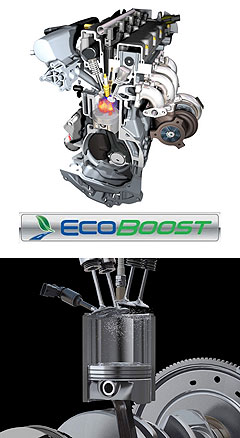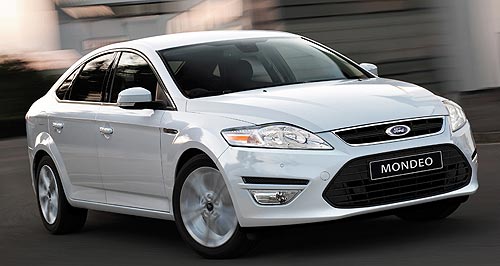Make / Model Search
Future models - Ford - Mondeo - EcoBoostFord EcoBoosts MondeoEcoBoost: Ford's new turbo-petrol will make its local debut in mid-2011 in the updated Mondeo, bringing more power and better fuel economy. Turbo-petrol EcoBoost engine to grace Mondeo before powering Falcon next January15 Mar 2011 FORD has confirmed its new turbocharged 2.0-litre EcoBoost petrol engine will make its Australian debut in a Blue Oval model under the bonnet of the facelifted Mondeo in mid-2011, before a more powerful version becomes available in the upgraded 2012 Falcon by next January. The EcoBoost turbo-four that will make its global rear-wheel drive debut in the Falcon by year’s end should offer similar outputs to the Ford-sourced 177kW/320Nm EcoBoost engine that became available in Volvo’s MY11 XC60 and S60 last week. Ford’s similarly sized Mondeo, however, will come with a 149kW/300Nm version of the direct-injection EcoBoost engine, which will replace the current 2.3-litre petrol engine that now powers Mondeo Zetec and Titanium hatch models. The 2.3 will remain available only on entry-level LX hatch and wagon versions of the facelifted MC Mondeo, LX and Zetec versions of which began rolling on to Ford dealer forecourts in mid-November before being joined by top-shelf Titanium variants late last month. Ford’s 2.0-litre TDCi turbo-diesel will be the only engine available for Zetec and Titanium wagon variants, after the 2.3-litre petrol Zetec wagon is discontinued as part of the EcoBoost engine’s introduction to the Mondeo range. Australians will not have access to 1.6-litre TDCi Econetic or 2.2-litre turbo-diesel versions of Ford’s latest Mondeo, but the introduction of EcoBoost power for the Mondeo is significant as the first in a number of local applications for Ford’s new downsized turbo-petrol engine family, which will also be seen in the Falcon and the range-topping ST/XR version of this year’s third-generation Focus.  Due on sale here in the third quarter, the latter is one of four vital new models for Ford in Australia this year, with the facelifted SZ Territory to offer diesel power for the first time from May, the locally developed T6 Ranger ute to arrive in the third quarter and the final quarter’s facelifted Falcon to come with both four-cylinder and liquid-injection LPG power for the first time. Due on sale here in the third quarter, the latter is one of four vital new models for Ford in Australia this year, with the facelifted SZ Territory to offer diesel power for the first time from May, the locally developed T6 Ranger ute to arrive in the third quarter and the final quarter’s facelifted Falcon to come with both four-cylinder and liquid-injection LPG power for the first time.As such, Ford Australia describes 2011, when it will replace or significantly update close to 85 per cent of its model range – as its year of innovation and makes much of the EcoBoost technology that has been available for some time in Europe’s S-Max and Galaxy people-movers and North America’s Edge crossover. EcoBoost combines direct-injection with turbocharging to deliver fuel consumption and CO2 emissions reductions of up to 20 per cent compared to conventional petrol engines, while offering the performance of a larger-displacement engine. Compared to the Mondeo’s current 118kW/208Nm 2.3-litre naturally aspirated petrol four, the ‘EcoBoost 2.0L GDTi’ engine produces 26 per cent more power (149kW or 200hp at 6000rpm) and 44 per cent more torque (300Nm between 1750 and 4500rpm), with 90 per cent of peak torque said to be on tap between 1400 and 5500rpm. At the same time, it returns combined ADR 81/02 fuel economy of 8.0L/100 km – down from the 2.3’s 9.5L/100km – and a highway cycle figure of just 6.3L/100 km. CO2 emissions are stated at 187g/km. Apart from latest-generation high-pressure (125-bar) direct fuel-injection and low-inertia turbocharging (in this case a Borg Warner K03 snail with rotors that spin at more than 200,000rpm), the Mondeo’s – and therefore the Falcon’s higher-out version – all-aluminium EcoBoost engine features twin independent variable camshaft timing (Ti-VCT). In the Mondeo, the DOHC 16-valve 2.0-litre EcoBoost GTDi (Gasoline Turbocharged Direct Injection) engine will be matched exclusively with Getrag’s six-speed Ford PowerShift double wet-clutch automatic transmission, which is already available with the Mondeo’s 120kW 2.0-litre Duratorq TDCi diesel engine and in selected Focus models. As the first EcoBoost engine to go fully global, the 2.0-litre powerplant is produced at Ford's Valencia engine plant in Spain. However, Ford plans to build about 1.5 million EcoBoost engines globally by 2013 – by which time it expects the technology to be available in 80 per cent of the company's global nameplates – with 750,000 of them assembled in the US, where diesel passenger cars are not popular. Ford says it holds more than 125 EcoBoost patents and patent applications – mainly related to the proprietary powertrain management strategy it employs to reduce turbo lag and optimise engine and transmission output – as part of its current roster of 4618 active and thousands of pending US patents. Ford Australia president and CEO, Bob Graziano said the new family of Ford EcoBoost petrol engines represented a key element of Ford's global 'Blueprint for Sustainability’. “We believe that these engines will provide customers with a genuinely attractive alternative to diesel or hybrid power units, delivering highly competitive fuel economy and cost-of-ownership, along with the responsive performance and wide rev range that have made petrol engines the favoured choice for so many drivers,” he said.  Read moreAll future models Alfa Romeo Alfa Romeo Abarth Abarth Alpine Alpine Alpina Alpina Audi Audi Aston Martin Aston Martin BMW BMW Bentley Bentley Chery Chery Brabham Brabham Chrysler Chrysler Chevrolet Chevrolet Cupra Cupra Citroen Citroen DS DS Dodge Dodge Fiat Fiat Ferrari Ferrari Foton Foton Ford Ford Great Wall Great Wall FPV FPV Haval Haval GWM GWM Honda Honda Holden Holden Hummer Hummer HSV HSV Infiniti Infiniti Hyundai Hyundai Jaguar Jaguar Isuzu Isuzu Kia Kia Jeep Jeep Land Rover Land Rover Lamborghini Lamborghini Lexus Lexus LDV LDV Mahindra Mahindra Lotus Lotus Mazda Mazda Maserati Maserati Mercedes-AMG Mercedes-AMG McLaren McLaren MG MG Mercedes-Benz Mercedes-Benz Mitsubishi Mitsubishi Mini Mini Opel Opel Nissan Nissan Peugeot Peugeot Pagani Pagani Proton Proton Porsche Porsche Renault Renault Ram Ram Rover Rover Rolls-Royce Rolls-Royce Skoda Skoda Saab Saab SsangYong SsangYong Smart Smart Suzuki Suzuki Subaru Subaru Toyota Toyota Tesla Tesla Volvo VolvoMondeo pricing
Motor industry news |
Click to shareFord modelsResearch Ford All future models Alfa Romeo Alfa Romeo Abarth Abarth Alpine Alpine Alpina Alpina Audi Audi Aston Martin Aston Martin BMW BMW Bentley Bentley Chery Chery Brabham Brabham Chrysler Chrysler Chevrolet Chevrolet Cupra Cupra Citroen Citroen DS DS Dodge Dodge Fiat Fiat Ferrari Ferrari Foton Foton Ford Ford Great Wall Great Wall FPV FPV Haval Haval GWM GWM Honda Honda Holden Holden Hummer Hummer HSV HSV Infiniti Infiniti Hyundai Hyundai Jaguar Jaguar Isuzu Isuzu Kia Kia Jeep Jeep Land Rover Land Rover Lamborghini Lamborghini Lexus Lexus LDV LDV Mahindra Mahindra Lotus Lotus Mazda Mazda Maserati Maserati Mercedes-AMG Mercedes-AMG McLaren McLaren MG MG Mercedes-Benz Mercedes-Benz Mitsubishi Mitsubishi Mini Mini Opel Opel Nissan Nissan Peugeot Peugeot Pagani Pagani Proton Proton Porsche Porsche Renault Renault Ram Ram Rover Rover Rolls-Royce Rolls-Royce Skoda Skoda Saab Saab SsangYong SsangYong Smart Smart Suzuki Suzuki Subaru Subaru Toyota Toyota Tesla Tesla Volvo VolvoMondeo pricing
Motor industry news |











Facebook Twitter Instagram